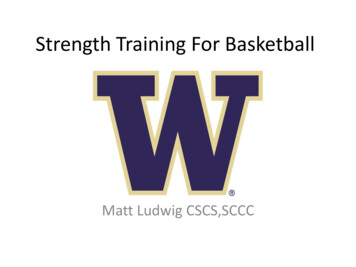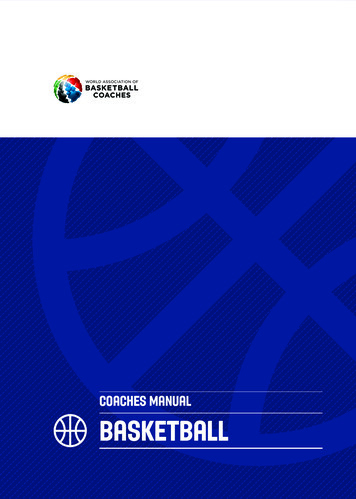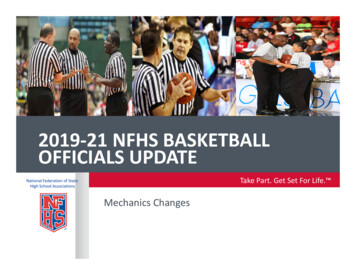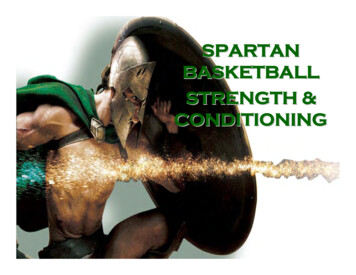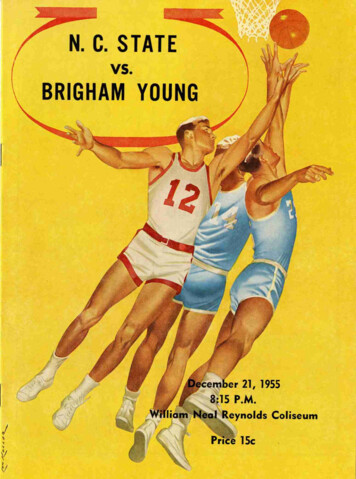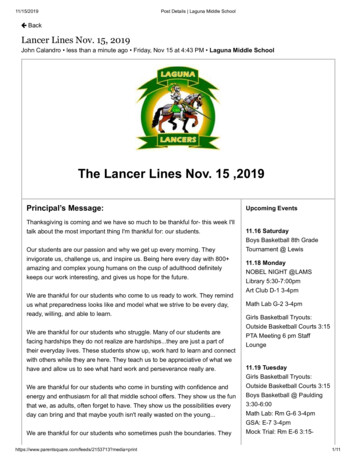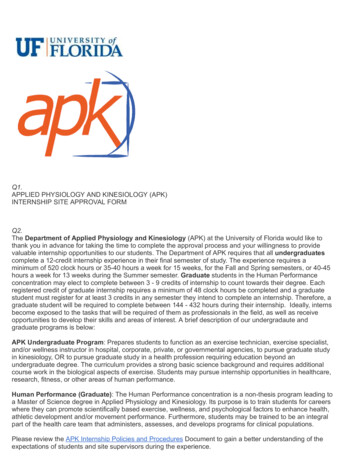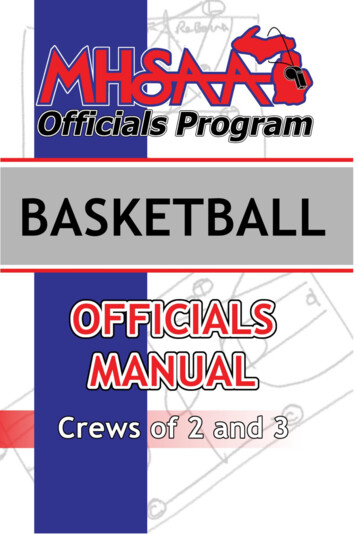
Transcription
BasketballOfficials ManualCrews of 2 and 3MHSAA OFFICIALS PROGRAM
MHSAA Press2019Copyright 2019 by Michigan High School Athletic AssociationAll rights reserved. This manual or any portion thereof may not bereproduced or used in any manner whatsoever without the express writtenpermission of the publisher except for the use of brief quotations in a bookreview, scholarly journal or training materials by Local ApprovedAssociations of the Michigan High School Athletic Association.First Printing: 2019www.mhsaa.com/officials
ContentsAcknowledgement .viIntroduction .1Section 1: General Basketball Officiating .3I)MHSAA Basketball Rules Fundamentals .3II) Helpful Hints for Officiating Basketball .5III) Officiating Character, Conduct and Ethics .6IV) Personal Responsibilities .8A) Physical Conditioning .8B) Knowledge of Rules, Mechanics and Signals .8C) Hustle .10D) Uniform .10V) Officials’ Communication .11A) Assignment Preparations .11B) Pregame Crew Conference .12C) Double Whistles .12D) Inadvertent Whistles/Horns .16E) Communication with Coaching Staffs .17F) Correctable Errors .19VI) Pregame Responsibilities .22A) Meeting with Game Administrator .22B) Conference with Captains and Coaches .23C) Meeting with Officials Timer and Official Scorer .25Section 2: Situation Management .27I)Players .27A) Fifth Foul Disqualification .28B) Ejections .28
II) Coaches . 28III) Spectators . 29IV) Report Writing . 30Section 3: Terminology and Concepts (Alphabetical by Topic) 31Section 4: Jump Ball . 44I)2-Person System Mechanics . 44A) Referee . 44B) Umpire . 46C) Player Control Gained in the Frontcourt . 46D) Player Control Gained in the Backcourt . 47II) 3-Person System Mechanics . 48A) Referee . 48B) Umpires . 49C) Umpire (U1) . 50D) Umpire (U2) . 50E) Player Control Gained by Team on Referee’s Right . 50F) Player Control Gained by Team on Referee’s Left . 51G) Ball Tipped Deep into the Backcourt . 52Section 5: Throw-Ins . 54I)General Throw-In Provisions . 54II) 2-Person System Mechanics . 57A) Backcourt End Line Throw-In . 57B) Sideline Throw-In . 58C) Frontcourt End Line Throw-In . 60D) Starting a Period or After Technical Foul Free Throws . 61E) Player Coverage . 62F) Press Coverage . 62III) 3-Person System Mechanics . 63A) Backcourt End Line Throw-In . 63
B) Sideline Throw-In .64C) Frontcourt End Line Throw-In .65D) Starting a Period or After Technical Foul Free Throws .66E) Player Coverage .67F) Press Coverage .67Section 6: Free Throws .69I)2-Person System Mechanics .69A) General Provisions .69B) Lead Official .70C) Trail Official .74II) 3-Person System Mechanics .76A) General Provisions .76B) Lead Official .78C) Center Official .81D) Trail Official .83III) All Officials Responsibilities .84A) Each Official .84Section 7: Court Coverage .85I)2-Person System Mechanics .85A) General Provisions .85B) Lead Positioning .87C) Trail Positioning .88D) On-Ball/Off-Ball .88E) SCA: Secondary Coverage Area Principles .89F) Five-Second Closely Guarded Count .90G) Drive to Basket .91H) Line Coverages .91I)Delay or Spread Offense .93J) Press Coverage .93
K) Ball-Side Mechanic . 93L) Field Goal Attempts and Rebounding . 95M) Three-Point Try . 96N) Signaling . 98O) Transition Coverages . 98P) Last-Second Shot . 99II) 3-Person System Mechanics . 102A) Prime Objective of the 3-Person System . 102B) Lead Positioning . 103C) Center Positioning. 104D) Trail Positioning . 105E) Primary Coverage Areas (PCAs) . 106F) On-Ball/Off-Ball . 107G) SCA: Secondary Coverage Area Principles . 108H) Five-Second Closely Guarded Count . 109I)Three-Second Count . 110J) Drive to Basket . 110K) Line Coverages . 111L) Field Goal Attempts and Rebounding . 113M) Three-Point Try . 114N) Press Coverage . 115O) Rotation Principles . 117P) Lead Rotates. 119Q) Center, After Lead Rotates . 121R) Trail, As Lead Rotates . 122S) Field Goal Attempts and Rebounding . 122T) Signaling . 123U) Transition Coverages . 123V) Last-Second Shot . 126
Section 8: Violations .130I)Procedures.130II) Out-of-Bounds Violations .131III) Free Throw Violations .133IV) Basket Interference/Goaltending Violations .133A) 2-Person System Mechanics.133B) 3-Person System Mechanics.134Section 9: Fouls .135I)Site of the Foul .135II) Reporting .137III) Non-Reporting Official(s) .139IV) Disqualification Procedure .140V) Dead Ball Switching .141A) 2-Person System Mechanics .141B) 3-Person System Mechanics .145Section 10: Held Ball .153Section 11: Time-outs .154I)Restrictions on Granting Time-Outs.154II) Erroneous Time-Outs.155III) Simultaneous Time-Out Requests .155IV) Injury Time-Outs .155A) Bleeding or Bloody Players .156B) Concussions .156V) Reporting Procedures .157VI) Positioning .158A) 2-Person System Mechanics .159B) 3-Person System Mechanics .160VII) Resuming Play .162Section 12: Intermissions .163
I)2-Person System Mechanics . 163II) 3-Person System Mechanics . 164Section 13: Substitutions . 165I)2-Person System Mechanics . 165II) 3-Person System Mechanics . 167Section 14: MHSAA Approved Signals . 169
AcknowledgementThe MHSAA could not administer its sports without the hard workand dedication of its officials. This publication was a result of thecollaboration between a number of MHSAA officials whose time andefforts are appreciated by administrators, coaches and officials alike.A special “thank you” to the contributors to the consultation, content,editing and publication processes.The MHSAA Officials Program wishes to thank the NationalFederation (NFHS) for its guidance in the production of this manual,and for the authorization to use its images for signals. PlayPicsprovided by the NFHS were produced by Referee magazine.vi
IntroductionThe purpose of MHSAA-produced mechanics manuals is toemphasize and promote consistency in rules knowledge andapplication, theory and philosophy and mechanics and signals. Thismanual serves as a guide to fundamental and emerging ideas,approaches and directions from the MHSAA in these areas. Thecontent provided in this manual establishes a base from which allofficials working MHSAA contests can consistently and successfullymanage a basketball game. This uniform approach will assureMHSAA member schools and their teams that they can rely on thesame approach to officiating regardless from which part of the statethey are located.Not everything that an official may encounter can be accountedfor and included in the text of a manual. Throughout the season,Points of Emphasis, Rulings and Interpretations and In-SeasonBulletins will be posted through the Basketball page of the Officialssection on the MHSAA website. Please check their regularly to findupdates and other resources to assist you in your officiating dutiesthroughout the year. You can find these Basketball.The content of this manual generally refers to both 2 and 3person systems. When particular mechanics or procedures areprovided for within either the 2 or 3-person system, but not the other,it will identified within the section.1
NOTE: Any reference in this manual to “he,” “him” or “his” shall bedeemed to reference to “she,” “her” or “hers,” as the case may be,when the person is a female.2
MHSAA Basketball Officials Manual – Crews of 2 and 3Section 1: General Basketball OfficiatingI) MHSAA Basketball Rules Fundamentals While the ball remains live, a loose ball always remains incontrol of the team whose player last had control, unless itis a try or tap for goal. Neither a team nor any player is ever in control during adead ball, jump ball, or when the ball is in flight during atry or tap for goal. A goal is made when a live ball enters the basket fromabove and remains in or passes through unless canceledby a throw-in violation or a player control foul. The jump ball, the throw-in and the free throw are the onlymethods of getting a dead ball live. Neither the dribble nor traveling rule operates during thejump ball, throw-in or free throw. It is not possible for a player to travel during a dribble. The only infractions for which points are awarded aregoaltending by the defense or basket interference at theopponent’s basket. There are three types of violations – and each has its ownpenalty. A ball in flight has the same relationship to front court orbackcourt, or inbounds or out of bounds, as when it lasttouched a person or the floor.3
MHSAA Officials Program Personal fouls always involve illegal contact and occurduring a live ball, except a common foul by or on anairborne shooter. The penalty for a single flagrant personal or flagranttechnical foul is two free throws and disqualification plusawarding the ball to the opponents for a throw-in. Penalties for fouls are administered in the order in whichthe fouls occurred. A live-ball foul by the offense (team in control or last incontrol if the ball is loose) or the expiration of time for aquarter or extra period, causes the ball to become deadimmediately, unless the ball is in flight during a try or tapfor goal.The ball also becomes dead when a player-control foul occurs. The first or only free throw violation by the offense causesthe ball to become dead immediately. A double personal foul involves only personal fouls andonly two opponents; no free throws are awarded and theball is put in play at the point of interruption. A doubletechnical foul involves only technical fouls and only twoopponents; no free throws are awarded, and the ball is putin play at the point of interruption. The official’s whistle seldom causes the ball to becomedead (it is already dead). Continuous motion applies both to tries and taps for fieldgoals and free throws, but it has no significance unlessthere is a foul by the defense during the interval which4
MHSAA Basketball Officials Manual – Crews of 2 and 3begins when the habitual trying or tapping movementstarts and ends when the ball is clearly in flight. Whether the clock is running or is stopped has noinfluence on the counting of a goal. A ball that touches the front face or edges of thebackboard is treated the same as touching the floorinbounds, except that, when the ball touches the thrower’sbackboard, it does not constitute a part of a dribble. If the ball goes through the basket before or after a playercontrol foul, the goal must not be counted.II) Helpful Hints for Officiating Basketball Be mentally and physically prepared to work thegame. Be professional, respectful and a good communicator. Display integrity, courage and poise. Your truecharacter is revealed in the tough calls. Use preventative officiating early and often. Use of approved signals present a professionalappearance and display confidence when timely, crispand thorough. An official’s emotions should not beconveyed through the signals he uses. Officials shoulduse calm and deliberate signals and avoid usingexaggerative mechanics that attract undue attention. Hustle and move with a purpose! Every movementshould improve your angle to get a better look at theplay.5
MHSAA Officials Program Understand that mistakes will occur. Don’t dwell onmissed calls and don’t make excuses. Move on andcontinue to officiate. Officiatingbasketballismorethandeterminingwhether a contact foul occurred – it is about ensuringat an advantage/disadvantage is created by thecontact. Criticism should be expected. Constructive criticism bypeers, observers, assigners, veteran officials orMHSAA officials should not only be accepted; it shouldbe solicited. Most criticisms from fans, coaches andplayers about decisions and rulings should initially beignored; however, personal attacks should never beaccepted. The idea of earning respect suggests that officialsaren’t entitled to respect until they prove themselves.Demanding respect may get compliance through fearand intimidation, but isn’t really respect at all. Rather,officials should command respect by their presence,demeanor and approach. Officials maintain the integrity of the sport. If anofficial’s personal integrity is questioned, it inhibits hisability to control the game in an effective manner.III) Officiating Character, Conduct and EthicsAn official is nothing without integrity. When others questionan official’s judgment, rules knowledge and timing, they shouldstill be able to rely on his character and ethics. The MHSAA6
MHSAA Basketball Officials Manual – Crews of 2 and 3Officials Guidebook provides a number a specific ethical andconduct standards for which officials must adhere in order tomaintain registration with the MHSAA. These include, but are notlimited to, the Code for MHSAA Athletic Officials, Social MediaGuidelines and the Conflict of Interest Policy.Additionally, officials should maintain the following charactertraits: Have ambition, but also patience. Newer officials t early in their careers. Don’t be jealous, but instead supportive, of anotherofficial’s good fortune and opportunities. Be receptive and willing to accept advice from anyofficial. Take what you can use and disregard thethings that don’t apply. Be honest with yourself. Set and keep realisticexpectations with your skills and abilities in mind. Be a leader by example. Adopt a philosophy to helpothers reach their goals. Having passion for officiating will make you a betterofficial because it gives you drive to improve yourskills, makes you interested in studying rules andmechanicsandinspirescomraderywithyourcrewmates. Be courageous and have conviction. Do what is righteven when it’s not easy or popular.7
MHSAA Officials Program Show poise and self-control, and treat players andcoaches like you would like to be treated.IV) Personal ResponsibilitiesA) Physical ConditioningBasketball officiating requires commitment both mentallyand physically, and appropriate physical conditioning isnecessary to maintain adequate coverage of responsibilitiesduring a contest. It is recommended that officials have regularphysical examinations and monitor health concerns.Officials should not use the beginning of the season to getinto proper shape. An old adage says to stay in shape ratherthan get in shape. Both the season and off-season has itschallenges in this area, and our busy lives often make itdifficult to take the necessary steps to maintain a healthylifestyle. However, taking the time throughout the year to eathealthy, remain active and address physical health concernsas they arise will help the process of transition into a newseason.Officials should not take on more than they can physicallyhandle. A season schedule should be limited to only the leveland number of games that he can reliably and respectablyofficiate, considering his physical conditioning, skills andabilities, knowledge and proficiency.B) Knowledge of Rules, Mechanics and SignalsFor proper management of a basketball game andseason, concrete knowledge of the rules of the game and the8
MHSAA Basketball Officials Manual – Crews of 2 and 3mechanics of the system are essential. This requires a greatdeal of time and study. It also is a community effort – rulesand mechanics should be discussed regularly amongst otherofficials to allow for input as to proper understanding,interpretation and application.Rules should be consistently and fairly enforced andwithout deviation from the NFHS playing rules. The intent ofeach rule should be kept in mind, and officials shouldmaintain a balance between strict enforcement and chaos.There are times when a technical application of a rule isdetrimental to the spirit of the rule, and officials should be ableto recognize the importance of using common sense and fairplay to supplement their enforcement of the rules.Proper positioning, knowledge of keys and court coverageresponsibilities are mastered through an extensive knowledgeof the mechanics of the system. Each official must have athorough understanding of his duties in the assigned position,as well as those of the officials on the crew. He should beconfident in the system and his crewmates’ abilities to focuson the tasks at-hand; but also be prepared to assist acrewmate when appropriate, within the rules and mechanicsand after fulfilling all of his own responsibilities for a play.The prescribed signals of the NFHS and the MHSAA arein place to communicate the action that is happen or that hasalready occurred. These approved signals convey neededinformation to timers, crew members, players, scorers,coaches, spectators, media, etc. They should be presented ina clear and professional manner, calm and unhurried and not9
MHSAA Officials Programoverly-emphatic. Unapproved mechanics, or those that areintended to draw undue attention to oneself, should beavoided.C) HustleHustle is moving to get into position quickly, but with apurpose and proper understanding of distance and angle.Hustling is not simply running fast. It’s understanding thesystem in which an official is working and recognizing theimportance of efficient movements within the system toensure the best positioning possible for developing plays.Some officials that run just for the sake of appearancemay actually put themselves out of position. Understandingwhen it’s necessary to hustle is a matter of experience andinstinct – the later often developed as a result of the former.This is not an excuse, however, to be lackadaisical on thecourt. Keep in mind this philosophy: Never walk with youshould jog, and never jog when you should run.D) UniformAn official’s appearance in his uniform is the firstimpression provided to coaches and administrators. Evenbefore the first jump ball, they are judged on their appearanceand demeanor. Much of this impression is attributed to thecleanliness and condition of the uniforms being worn. Theproper uniform and accessory requirements are found onpage 11 of the Officials Guidebook. Officials should reviewthis annually to stay abreast of MHSAA uniform expectations10
MHSAA Basketball Officials Manual – Crews of 2 and 3and changes. Experimental uniforms or those worn byofficials in other levels or organizations are not approved.V) Officials’ CommunicationA) Assignment PreparationsCommunication is essential for a crew to operateefficiently and effectively during a game. This includescommunication amongst the crew even before the gamebegins. The week of, and at least two days before the contestdate, the Umpire(s) should confirm the details of theassignment to the Referee (or the first person listed on theassignment, if no Referee is designated). After receivingconfirmation from his partner(s), the Referee should confirmreceipt through an email to the school’s athletic director withthe Umpire(s) cc’d. This email should include: Time administrator should expect the officials toarrive on site Request for the location the officials are expectedto park Request for time and location the officials shouldmeet the site administrator A request for any information relating to specialactivities or events that might be planned aroundor within the game A reminder that the NFHS and MHSAA aremandatingconferenceswiththeon-siteadministrator (request/suggest a time and location)11
MHSAA Officials Program A request for confirmation/follow-up from theadministratorAdequate information is critical to ensuring that silence orassumptions don’t lead to mistakes regarding location, time orpartners assigned. If there is a lack of communication, makeevery attempt to resolve it.B) Pregame Crew ConferenceTo make certain that crewmates are on the same page,generally, and for the upcoming contest, the officials shoulddedicate sufficient time and attention to a crew pregamediscussion of topics relating to mechanics, signals and teamsinvolved. Details should be laid out in a comprehensivepregame outline. Take time to review new rules, points ofemphasis and positioning and mechanics changes. Topicsshould also include game management, clock awareness,court coverage principles and rotations, double whistles andcrew communication. Challenging situations are also timelyand significant issues for mutual conversation prior to takingthe floor.C) Double arrassing, do occur from time-to-time and are a result ofcrew miscommunication – whether due to a lack of knowledgeof responsibilities, inadequate preparation before the game orpoor visual communication during the play. When/where they12
MHSAA Basketball Officials Manual – Crews of 2 and 3occur, and how they’re resolved, determine the severity of theissue at-hand. Double whistles fall into the followingcategories:1. Tolerable: Infrequent and somewhat unavoidablesituations such as when a ruling needs to be madeclosed to intersecting primary coverage areas (PCA)boundaries and out-of-bounds boundary lines, or withoccasional “two-referee plays.”2. Unnecessary: Due to one official ball-watching outsideof PCA.3. Marginal: Multiple instances when official(s) areblowing the whistle outside of PCA, and having torepeatedly get together to determine what the otherruled and what to report.4. Unacceptable: Multiple officials whistling and thensignaling different rulings.Double whistles primarily occur as a result of ballwatching outside of PCA, lack of knowledge of PCAs, ahabitual impulse to blow the whistle or an emotionalinclination to take over the game. Repeated instances of thisthroughout a game gives an indication of indecision and theappearance that the crew does not work well together. Whilenot ideal in any circumstance, it is better to have matchingcalls than contradicting ones. Communication, includingproper eye contact, is the key in mitigating the effects of adouble whistle.13
MHSAA Officials ProgramPreventative MeasuresTo protect against, and mitigate the effect of, doublewhistles, officials should maintain the following practices:First, every time a foul is whistled, the calling officialshould look to the nearest official to his PCA to make surea double whistle has not occurred. This is especiallyimportant in the lane and on drives
dead ball, jump ball, or when the ball is in flight during a try or tap for goal. A goal is made when a live ball enters the basket from above and remains in or passes through unless canceled by a throw-in violation or a player control foul. The jump ball, the throw-in and the free
